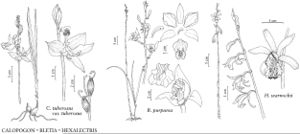Hexalectris
Neogenyton, 4. 1825.
Herbs, perennial, terrestrial, leafless, rootless, mycotrophic, solitary or colonial. Rhizomes branching, articulate, annular, stout. Stems erect, yellowish-brown, pink, pinkish red, or reddish purple, glabrous; sheathing bracts 2–5, reduced. Inflorescences racemes, consisting of entire aboveground portion of plant. Flowers 2–25, resupinate, tan, brown, magenta, purple, or maroon; dorsal sepal lanceolate; lateral sepals falcate to lanceolate, base distinct and free; petals linear, lanceolate, or elliptic; lip 3-lobed; lamellae 3–5 (–7), prominent; column arcuate, apex narrowly winged; anthers terminal, white, yellow, or maroon; pollinia 8, firm, in 4 pairs, 2 pairs per anther cell; stigma subterminal. Fruits capsules, pendent, ellipsoid; seeds 0.5–0.7 mm.
Distribution
Neotemperate and neotropical, mostly Mexican
Discussion
Species 7 (5 in the flora).
Rafinesque’s choice of the name Hexalectris was probably inappropriate because plants in the genus tend to have five or seven crests on the lip (C. A. Luer 1975; J. Liggio and A. Liggio 1999).
Examination of material, both living and preserved, suggests that a species complex exists that involves Hexalectris nitida, H. revoluta, H. spicata in the broad sense, and the Mexican and Guatemalan H. parviflora. This is a complicated group, some plants of each species resembling plants of another species within the complex. Hexalectris spicata var. arizonica possibly is a hybrid-derived taxon from H. nitida and H. spicata var. spicata, or the latter species and H. revoluta (P. M. Catling and V. S. Engel 1993), although plants with cleistogamous flowers of H. nitida are often similar to H. spicata var. arizonica. A number of recent significant range extensions have been noted for H. nitida (V. S. Engel 1987), H. revoluta (R. A. Coleman), and H. warnockii (V. S. Engel 1987; G. A. Salazar-Chavez 1991), suggesting that members of this genus lurk unsuspected over a very large geographic area; they may be more common than currently assumed. Because relatively few herbarium collections have been made for this genus, particularly in the western United States and Mexico, it is clear that more has yet to be understood about the biology and taxonomy of the members of this complicated genus. Based on plastid DNA sequences, it has been estimated that Hexalectris is most closely related to the neotropical genera Basiphyllaea and Bletia (D. H. Goldman 2000; D. H. Goldman et al. 2001).
Selected References
None.
Lower Taxa
Key
| 1 | Lateral sepals 7–12 mm; lip 7–11 mm; column 6–8 mm; anthers yellow. | Hexalectris nitida |
| 1 | Lateral sepals longer than 12 mm; lip 10–20 mm; column 9–18 mm; anthers whitish. | > 2 |
| 2 | Petals and sepals dark purple to maroon, not recurved; lip with 5 yellow-margined, undulate lamellae; anthers reddish to maroon. | Hexalectris warnockii |
| 2 | Petals yellowish brown, pinkish brown, or pink to rose pink, weakly to strongly recurved; lip with 3–7 white or purple, smooth, ± straight lamellae; anthers white to yellow. | > 3 |
| 3 | Lip with 5–7 typically purple to white lamellae; lip shallowly 3-lobed, fissure less than 2 mm deep. | Hexalectris spicata |
| 3 | Lip with 3–7 white to yellow lamellae; lip deeply 3-lobed, fissure more than 3 mm deep. | > 4 |
| 4 | Petals and sepals pink to crimson, slightly recurved; lip with 5 white lamellae. | Hexalectris grandiflora |
| 4 | Petals and sepals pinkish brown, strongly recurved; lip with 3–7 obscure white to yellow lamellae. | Hexalectris revoluta |

